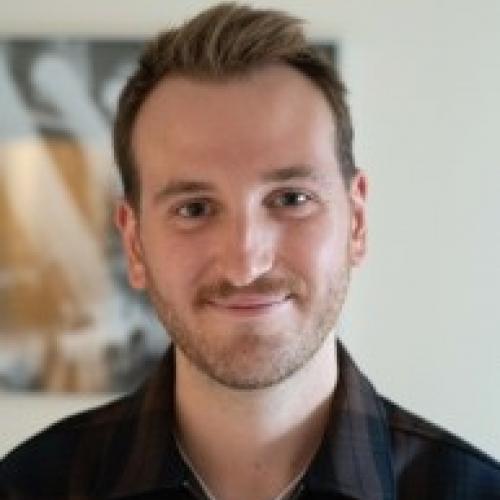
Dr Alexander Cook
Here at Pembroke, I am the BTP Junior Research Fellow in Biochemistry and I teach biophysical methods and protein structure to Biochemistry undergraduates. The rest of the time, I can be found in the Department of Biochemistry, where I use biophysics to discover and describe how surface proteins on trypanosome parasites interact with and modulate the human innate immune system.
The diversity and brilliance of the natural world has fascinated me since my childhood days where my ornithologist Grandad would show us incredible Australian wildlife. Biochemistry is the study of the natural world where the forest full of animals becomes cells full of molecules – each with a distinctive shape, behaviour, and environment. To observe this nanoscale world, however, requires dedicated biophysical equipment. As a visual person, there is no aspect of my work I love more than structural biology – where I use cryogenic electron microscopy and X-ray crystallography to obtain the 3D shape of different proteins. Using these methods enables me to visualise exactly how trypanosome proteins interact with proteins of the human innate immune system. I hope this work will help explain how these parasites can sustain such chronic infections – up to decades in some cases – despite living completely exposed in our blood.
I graduated in Biochemistry from Cardiff University in 2014, before starting my PhD in London at Birkbeck with Prof. Carolyn Moores, where I cut my teeth on cryogenic electron microscopy looking at motor proteins from the malaria parasite. In June 2020, I joined the exciting molecular parasitology lab of Prof. Matthew Higgins.
- Macleod OJS*, Cook AD* et al. Invariant surface glycoprotein 65 of Trypanosoma brucei is a complement factor C3 receptor important for virulence. Under review. (2021). * these authors contributed equally.
- Cook AD, Roberts A, Atherton J, Tewari R, Topf M, and Moores CA. Molecular mechanism of a parasite kinesin motor and implications for its inhibition. J. Biol. Chem. (2021).
- Cook AD, Manka SW, Wang S, Moores CA & Atherton J. A microtubule RELION-based pipeline for cryo-EM image processing. J. Struct. Biol. 209, (2020).
Dr Cook is also Postdoctoral Research Associate at the Department of Biochemistry.
Dr Alexander Cook

Here at Pembroke, I am the BTP Junior Research Fellow in Biochemistry and I teach biophysical methods and protein structure to Biochemistry undergraduates. The rest of the time, I can be found in the Department of Biochemistry, where I use biophysics to discover and describe how surface proteins on trypanosome parasites interact with and modulate the human innate immune system.
The diversity and brilliance of the natural world has fascinated me since my childhood days where my ornithologist Grandad would show us incredible Australian wildlife. Biochemistry is the study of the natural world where the forest full of animals becomes cells full of molecules – each with a distinctive shape, behaviour, and environment. To observe this nanoscale world, however, requires dedicated biophysical equipment. As a visual person, there is no aspect of my work I love more than structural biology – where I use cryogenic electron microscopy and X-ray crystallography to obtain the 3D shape of different proteins. Using these methods enables me to visualise exactly how trypanosome proteins interact with proteins of the human innate immune system. I hope this work will help explain how these parasites can sustain such chronic infections – up to decades in some cases – despite living completely exposed in our blood.
I graduated in Biochemistry from Cardiff University in 2014, before starting my PhD in London at Birkbeck with Prof. Carolyn Moores, where I cut my teeth on cryogenic electron microscopy looking at motor proteins from the malaria parasite. In June 2020, I joined the exciting molecular parasitology lab of Prof. Matthew Higgins.
- Macleod OJS*, Cook AD* et al. Invariant surface glycoprotein 65 of Trypanosoma brucei is a complement factor C3 receptor important for virulence. Under review. (2021). * these authors contributed equally.
- Cook AD, Roberts A, Atherton J, Tewari R, Topf M, and Moores CA. Molecular mechanism of a parasite kinesin motor and implications for its inhibition. J. Biol. Chem. (2021).
- Cook AD, Manka SW, Wang S, Moores CA & Atherton J. A microtubule RELION-based pipeline for cryo-EM image processing. J. Struct. Biol. 209, (2020).
Dr Cook is also Postdoctoral Research Associate at the Department of Biochemistry.